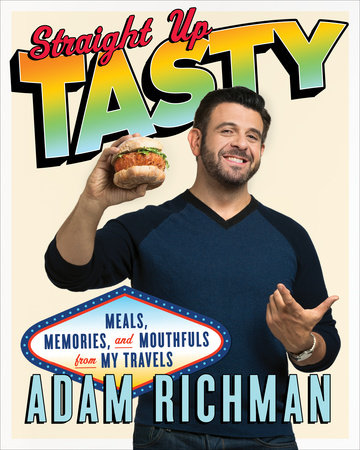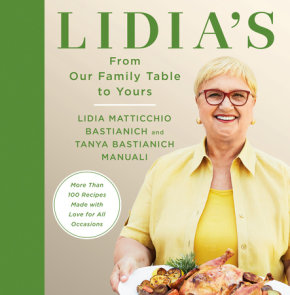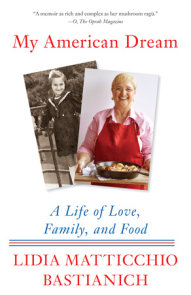Author Q&A
Q: How did you start cooking and when did you know it was your calling?
A: I always loved being around food. I loved preparing and cooking it, as well as growing and producing it. As a child, I helped my grandma Rosa tend her garden, feed the animals and prepare the vegetables, eggs and cheeses to sell at market. I would also stay by her side when she cooked, helping her knead bread and make pasta and gnocchi. For me, touching and preparing food always felt good. I can still recall the silkiness of the pasta dough she made and strive for that texture when I make pasta at home and at my restaurants. Being introduced to food at a very young age, and carrying these culinary traditions with me, I’m sure had a great deal to do with my chosen profession.
Q: In the book, you mention that you learned to cook native dishes from your Nona Rosa. What is your earliest memory of your grandmother?
A: My earliest memory is of running in my grandma Rosa’s courtyard chasing the ducks and chickens. We called them courtyard animals and they were part of the family. I specifically remember a white goose with a bright orange beak that would chase me; what she really wanted was the piece of bread or grain I had in my hands. I found out later that geese can be snappy, so I always carried a stick when she was around, but she did lay the biggest eggs, which would make the best and most yellow pasta.
Q: How did your life change when your family moved to New York City from Italy to escape communism?
A: It was a jolting change of gears from a tranquil, pastoral setting to the urban rhythms of a big city. For me, it was very exciting and challenging, but I was always nostalgic for my grandma and the friends I left behind. As Istria became part of communist Yugoslavia and the iron curtain went down, we were not allowed to leave or migrate and one member of the family had to remain in Istria as a hostage to ensure that the family would return. My mother and father had a plan of which we children were not aware. My mother, brother Franco, and I went back to Italy, supposedly to visit the part of the family that was left in Italy. My father, who remained, escaped past the border during the night while being shot at, to join us in Trieste. I was heart broken because I did not have the chance to say good-bye to grandma and my friends I had left behind.
Q: You opened your first restaurant at the age of 24. What was it like when you first started out in the restaurant business?
A: I knew I loved food and cooking and that people enjoyed what I cooked, but at that early age I didn’t have the knowledge and wasn’t savvy enough to run a restaurant. But sometimes passion pushes us to forge beyond our expectations. I do know that I felt very excited, I felt challenged and I recall being amazed that there were lines of people waiting to come and eat my food. I was thrilled that I could share the food of my heritage with complete strangers and they would enjoy and appreciate it. Over time, a bond was born, and I am still amazed at the trust and following that my clients have for me and my profession. After all, it has been thirty years that I have been cooking professionally and some of my first customers still visit with me at my restaurants today.
Q: How would you define Italian-American cuisine and why is it so popular?
A: Italian-American food is the crowning glory of the Italian immigrants’ struggle to adapt. It is a cuisine that reflects the spirit and beauty of the Italian culture. It is a cuisine that was born at the turn of the century when a large influx of Italians, predominantly from the regions of Campania and Sicily, came to America to make a new life. They came with few material things but a vast culture of food and products. With the memories they brought with them and the products they found, a cuisine of adaptation was born: Italian-American. Whatever I do I try to bring the true essence of what it is to be Italian and what it tastes like to be Italian. Americans love Italy and everything Italian; wherever I travel in the United States I see and sense the Italian style and flavor. It is the number one ethnic cuisine in the States and through my restaurants, I bring a piece of my Italy to America.
Q: In the cookbook, you talk a lot about your family. How has the energy and stimulation that you have received from your family shaped your culinary heritage and business?
A: My family sustains me. They are the basis of my being and the basis of my strength. Their love and support gives me the strength to work, to create, to move mountains. In the Italian culture, family is the very essence and center of our existence. I was very lucky to have my mother by my side from the first day I opened my restaurant. She was there to help me work, to help me raise my children and to give me support through rough periods. She still lives with us, and in turn I am blessed that my two children and their families are very close to me. We work together in what is now a family business of restaurants, wines, sauces, cookbooks and television.
Q: What has been your most exciting moment in the restaurant business?
A: My whole adult life has been in the restaurant business and it’s been a constant crescendo of challenges, satisfactions and rewards. But to have my children follow in what I have begun with such passion is the greatest reward. They will carry on.
Q: How did you come to start your television show?
A: Everything took off after I did a show on PBS with Julia Child in the Master Chef series. One episode was nominated for an Emmy. I guess I communicated my techniques and passion for food, but most of all I had a great time sharing my culinary culture with viewers. After that episode, a producer came calling and my television career was born.
Q: What is the difference between New World and Old World ingredients and how are these important to Italian-American cooking?
A: Ingredients from the New World–tomatoes, peppers, beans–were first incorporated in the Italian culture when they were brought to Italy by the explorers. These ingredients became major players in the Italian kitchen. Italians are very close to their products and the Italian climate is ideal for growing perfect vegetables, intense in flavor. When the Italian immigrants came to America at the turn of the century, they did not find all those wonderful products and vegetables they had left behind in Italy. They made concessions and adaptations which were the beginning of the Italian-American cuisine, a cuisine based on the same philosophy but substantially different in taste.
Q: What is your favorite dish to eat/prepare?
A: I do not have one favorite dish. That is like asking me which is my favorite child. I love them all the same. I love them all for different things. I love them all at different moments. But if I were stranded on a deserted island, give me pasta for the rest of my life and I would be happy.



























